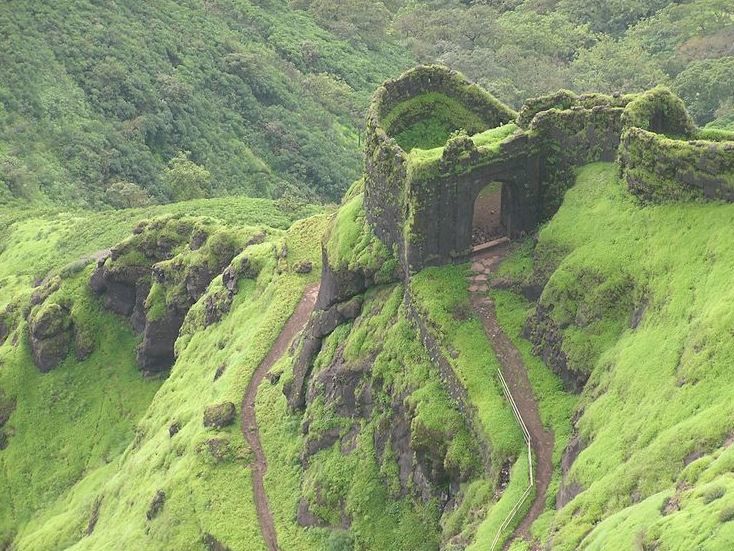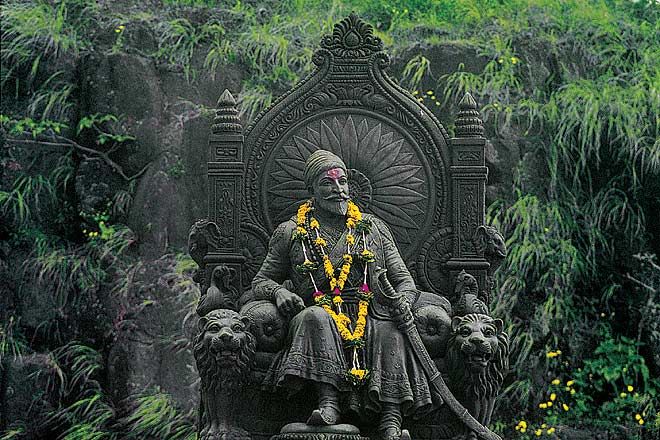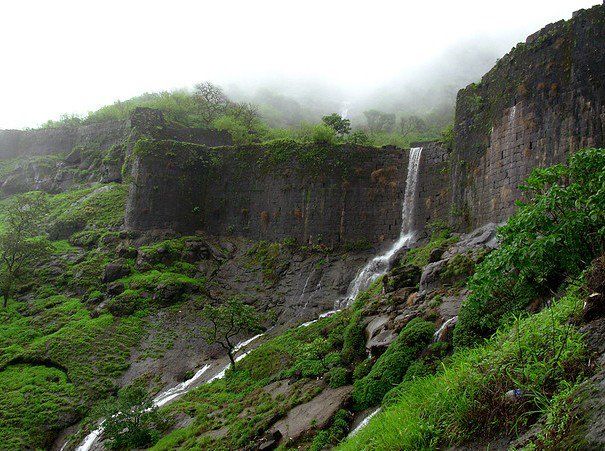
(Picture Courtesy : Wikimedia Commons)
The aesthetically appealing Raigad Fort is a strategically constructed hill fort in the Raigad district of Maharastra, India. Built by the vibrant Maratha ruler, Chhatrapati Shivaji Maharaj, Raigad was the capital city of the illustrious Maratha Sovereign in the old times. The fort is located in the Sahyadri mountain range, and is only accessible by a pathway on one side, through several steps in a stiff climb, while the other sides are surrounded by deep valleys draped in green. Called the “Gibraltar of the East” by the Europeans, the Raigad Fort consists of several gateways, namely, the Nagarkhana Darwaja, the Mena Darwaja, and the Palkhi Darwaja, along with the Maha Darwaja which is the main entrance to the fort and has a majestic ambience.
The strategic location of the fort, especially the Khoob Ladha Buruj tower which has interesting defense techniques, is the fort’s specialty and is a living reminder of the valor and the gloriousness of the Marathas. It is cut-off from the Western Ghats and heavily fortified.
The History of the Raigad Fort
The Maratha King, Shivaji who was coroneted here, built his capital city in the Raigad Fort after he seized it in 1656 from the royal house of Chandrarrao Mores, which was then known as the fort of Rairi. Shivaji renovated and expanded this fort and renamed it Raigad. Two very important villages, Pachad and Raigadwadi, were located in the base of this fort, and ten thousand cavalry were always kept standby in the Pachad village during the Maratha rule. In 1689, the Mughals captured this fort and Aurangzeb renamed it “Islamgad”. In 1765, the Raigad Fort was the target of an armed expedition by the British East India Company who saw it as a piratical stronghold and thereby bombarded and destroyed in 1818, and it was handed over to the same.

(Picture Courtesy: India Destinations)
In the present day, though the Raigad Fort is in ruins, it still entails the aura of grandness and splendor. Built in as early as 1030 AD, the ruins of Raigad Fort consist of the queen’s quarters or the ‘Rani Vasa’ with six chambers with attached private restrooms which could be entered from the Mena Darwaja. The main palace, the Raj Bhavan, which was Shivaji’s Palace, was made of wood of which only the bases of the pillars remain and in the palace grounds overlooking the Ganga Sagar Lake, there are the fragmented ruins of three watchtowers. The Royal Bath projects an impressive drainage system along with an underground cellar which was used for secretive and highly confidential activities! The Takmak Tok or the execution point is a cliff in the periphery were sentenced prisoners were pushed to death. There are also the ruins of the old marketplace and right in front is the statue of Shivaji himself that leads to the Jadgishwar mandir and his own tomb along with that of his dog, Waghya. The king’s public court or the Raj Sabha has the replica of the original throne that faces the Nagarkhana darwaja, whilst the enclosure was acoustically designed to aid hearing from even the entrance. Again, in the right side of the Palkhi darwaja is a row of three deep, dark chambers which were believed to be granaries of the fort. The Hirakani Buruj, the famous wall constructed over a huge cliff still stands strong even today. Holi Cha Mal situated outside the Nagarkhana is a wide open ground which was used for holi celebrations. Bara Tanki consisted of more than a dozen water reservoirs, along with Ammunition depot, Rameshwar Mandir, Wagh Darwaja, the Chit darwaja located in Pachad, are among other attractions of the fort.

(Picture Courtesy: Outlook Traveller)
Owing to the location and structure of the Raigad Fort, it has the best means for trekking, with varying interesting routes right from easy to challenging! The general trek starts at Pachad, 24 kilometers from Mahad, which is a shallow sea port on the banks of the Savitri River. Also, Fort Torana, Fort Lingana, Fort Mangad, and Birwadi, located in and around the Raigad Fort, provides some beautiful trek routes.
Presently, there is the Raigad Ropeway which helps visitors to reach the Raigad Fort, avoiding the arduous climb. It is a rather picturesque climb through the mist-laden clouds, touched upon by the wind. The Ropeway, built in 1996 which an interesting element of the fort, lands at the Mena Darwaja.

(Picture Courtesy: bhramanti365 )
The Raigad Fort is located at a favourable distance from both Mumbai and Pune. It is a two hour drive from Pune to the fort. One can reach the Raigad Fort from Mumbai in less than two hours by road, located 140 kilometers from the metropolis.
Along with it being a place of immense historical relevance, the Raigad Fort is also considered to be a sacred pilgrimage destination. The Raigad Fort is well-maintained, nurturing the nourishing green across the hilly terrain, thereby preserving its authenticity. No doubt, the best time to visit the Raigad Fort is in the Monsoons!
Frequent searches leading to this page:-
neemrana fort palace, nahargarh fort, raigad fort ropeway guest house, raigad fort ropeway contact number, raigad fort ropeway images

